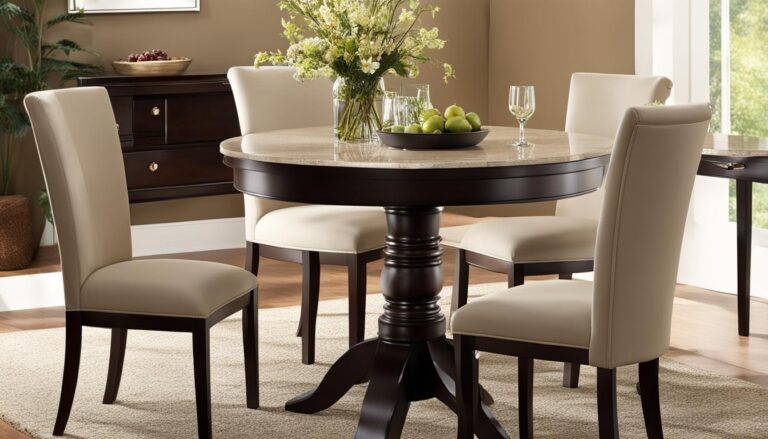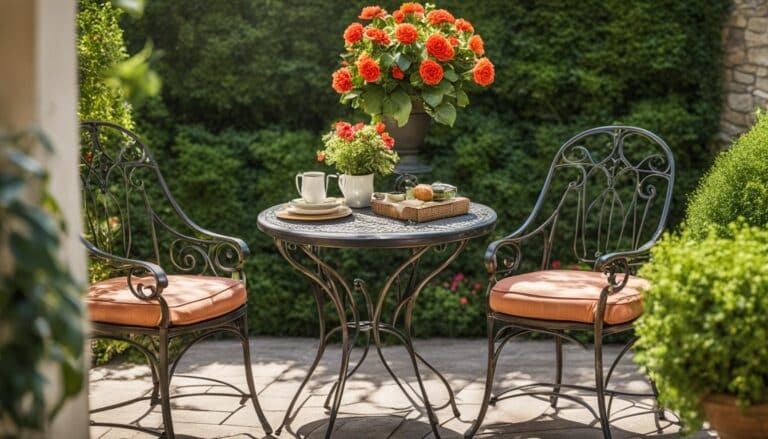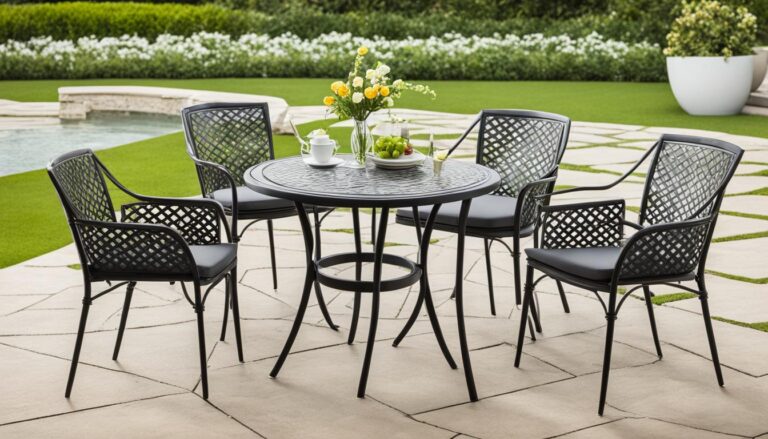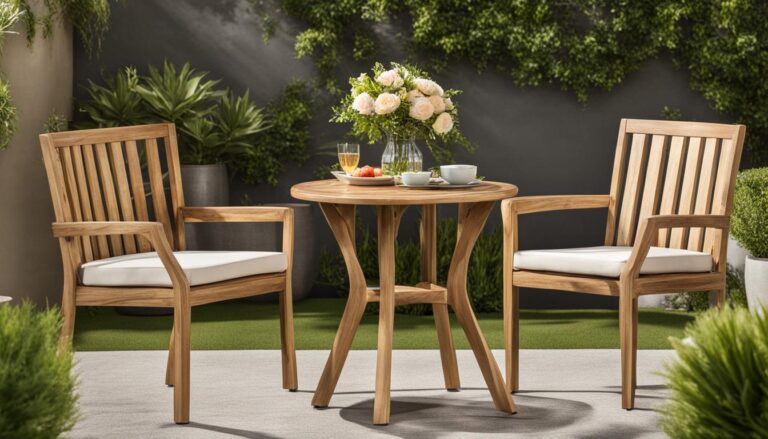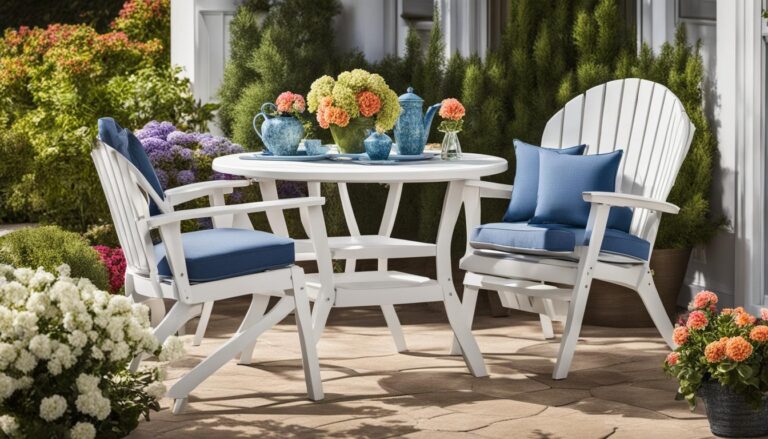h1 {
color: #333333;
font-size: 24px;
font-weight: bold;
margin-bottom: 16px;
text-align: left;
}
p {
color: #666666;
font-size: 16px;
line-height: 1.5;
margin-bottom: 16px;
text-align: justify;
}
img {
display: block;
margin: 0 auto;
max-width: 500px;
}
h3 {
color: #333333;
font-size: 20px;
font-weight: bold;
margin-bottom: 16px;
text-align: left;
}
ul {
color: #666666;
font-size: 16px;
line-height: 1.5;
margin-bottom: 16px;
}
Wood has been used for furniture for centuries due to its malleability, beauty, and versatility. When it comes to outdoor furniture, selecting the right wood is crucial for durability and longevity. So, what wood should you use for your outdoor furniture projects? Let’s explore the best wood options and factors to consider in this comprehensive guide.
Key Takeaways:
- Choosing the right wood is essential for the longevity of your outdoor furniture.
- Hardwoods such as teak and softwoods like cedar are popular options.
- Consider factors like budget, climate, and patio surface when selecting the wood species.
- Protecting your outdoor wood furniture with covers and high-quality protectants is crucial for maintenance.
- Recommended wood species for outdoor furniture include white oak, black locust, bald cypress, eastern red cedar, and northern white cedar.
Types of Wood for Outdoor Furniture
When it comes to choosing the ideal wood for your outdoor furniture, there are two main types to consider: hardwoods and softwoods. Both have their own unique characteristics and benefits that make them suitable for use in outdoor settings.
Hardwoods, such as teak, mahogany, and ipe, are known for their strength and density. Teak, in particular, is highly regarded as the best wood for outdoor furniture due to its natural oils that repel water, resist insects, and maintain stability in different humidity levels. These hardwoods not only offer exceptional durability but also provide a beautiful aesthetic with their rich colors and grain patterns.
On the other hand, softwoods like cypress, redwood, and cedar have their own advantages. These wood species have natural moisture-wicking properties and are resistant to decay, making them suitable for outdoor use. Softwoods offer a rustic charm with their distinctive grain patterns and color variations, adding a touch of natural beauty to your outdoor space.
Factors to Consider:
- Durability: Hardwoods provide superior durability and are less prone to warping and rotting.
- Aesthetic Appeal: Both hardwoods and softwoods offer unique grain patterns and colors, allowing you to choose a wood species that aligns with your desired aesthetic.
- Maintenance: Consider the level of maintenance required for each wood type. Hardwoods like teak are relatively low maintenance, while softwoods may require more regular staining or sealing.
- Budget: Keep in mind that hardwoods tend to be more expensive than softwoods, so consider your budget when making a decision.
By understanding the types of wood available for outdoor furniture and considering the factors mentioned above, you can make an informed decision that suits your needs and preferences. Whether you choose a hardwood or a softwood, maintaining and protecting your outdoor furniture will ensure its longevity and keep it looking beautiful for years to come.
Best Wood Options for Outdoor Furniture
When it comes to choosing wood for your outdoor furniture, durability is key. You want a wood species that can withstand the elements and provide long-lasting beauty. Here are some of the best wood options for outdoor furniture:
- Teak: Teak is renowned for its exceptional durability and weather resistance. Its natural oils repel water and insects, and it maintains stability in different humidity levels. Teak furniture can withstand harsh outdoor conditions and will develop a beautiful silver-gray patina over time.
- Acacia: Acacia is another excellent choice for outdoor furniture. It is known for its dense wood grains and resistance to warping. Acacia furniture is highly durable and can stand up to the demands of outdoor use.
- Black Locust: Black locust is a hardwood that is highly resistant to decay and rot. It is a sturdy option for outdoor furniture and can last for many years with proper care.
- Cedar and Redwood: Cedar and redwood, both softwoods, are naturally resistant to moisture, decay, and insect damage. They offer a combination of durability and aesthetic appeal, with their beautiful grain patterns and color variations.
These wood options are highly recommended for outdoor furniture due to their durability and ability to withstand outdoor conditions. Consider the specific needs of your outdoor space, such as climate and budget, when choosing the best wood option for your furniture.
Factors to Consider When Choosing Wood for Outdoor Furniture
When it comes to selecting the right wood for your outdoor furniture, there are several factors you should consider. By taking these factors into account, you can ensure that you choose a wood species that will not only withstand the elements but also provide long-lasting beauty and functionality for your outdoor space.
Budget
Your budget is an important consideration when choosing wood for outdoor furniture. Different wood materials come at various price points, so it’s essential to determine how much you’re willing to spend. While hardwoods like teak and mahogany may be more expensive, they offer exceptional durability and longevity. On the other hand, softwoods like cedar and pine are more affordable options that still provide excellent resistance to decay and insects.
Climate
The climate in your area plays a significant role in the durability of your outdoor furniture. If you live in a region with harsh winters, high temperatures, or heavy winds, it’s essential to choose weather-proof woods. Hardwoods like teak, ipe, and acacia are known for their ability to withstand extreme weather conditions. Softwoods like cedar and redwood are naturally resistant to moisture and decay, making them ideal choices for areas with high humidity.
Patio Surface
The surface of your patio or outdoor space can also impact your wood selection. If your patio is on a softer surface like grass or soil, it’s important to choose wood species that are resistant to pests, rot, and fungi growth. Hardwoods like teak and cedar are popular choices for these types of surfaces. However, if your patio has a concrete or stone surface, you have more flexibility in choosing the wood species since those materials provide a more stable and less susceptible base.
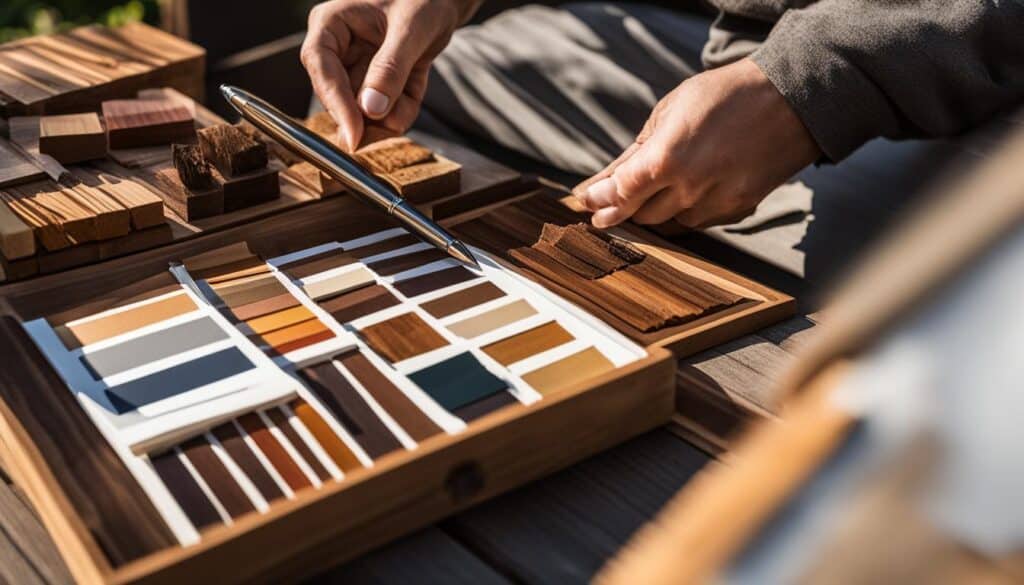
Outdoor Wood Furniture Protection
To ensure the longevity and beauty of your outdoor wood furniture, proper protection is essential. Here are some tips on how to protect your outdoor wood furniture:
- Use fitted furniture covers: Invest in high-quality fitted covers to shield your outdoor wood furniture from the harsh elements. These covers provide protection against UV rays, rain, and dust, helping to prevent fading, warping, and damage.
- Apply a high-quality protectant: Before using your outdoor wood furniture, apply a protective finish to seal the wood and create a barrier against moisture. Choose a water or oil-based protectant that is specifically designed for outdoor use. Penetrating oil finishes are easy to apply and offer excellent protection against weathering. Water-based protectants provide long-lasting color retention and are environmentally friendly.
- Regular maintenance and cleaning: Regularly clean your outdoor wood furniture using a simple solution of soap and water. Gently scrub the surface with a soft brush or sponge, then rinse thoroughly. This helps remove dirt, grime, and mildew that can accumulate over time. After cleaning, allow the furniture to dry completely before applying any protectant.
- Inspect and repair: Regularly inspect your outdoor wood furniture for any signs of damage, such as cracks, splits, or loose joints. Repair any minor issues promptly to prevent further deterioration. Sanding and refinishing may be necessary to restore the furniture’s appearance and protect it from future damage.
By following these protection tips, you can extend the lifespan of your outdoor wood furniture and keep it looking its best for years to come.
Recommended Wood Species for Outdoor Furniture
When it comes to selecting the right wood for your outdoor furniture projects, it’s important to choose species that are known for their durability and resistance to the elements. Here are five recommended wood species that are widely used by experienced craftsmen:
- White Oak: With its exceptional durability and natural resistance to decay, white oak is a popular choice for outdoor furniture. It is known for its strength and longevity, making it suitable for various weather conditions.
- Black Locust: This hardwood species is highly resistant to elements and insects, making it an excellent choice for outdoor furniture projects. It offers both durability and a unique appearance with its distinctive grain patterns.
- Bald Cypress: Known for its natural rot resistance, bald cypress performs exceptionally well in wet conditions. It is a versatile wood species that can withstand outdoor elements and provide long-lasting beauty.
- Eastern Red Cedar: This naturally rot-resistant softwood is a popular choice for outdoor furniture due to its pleasant aroma and unique reddish-brown color. Eastern red cedar offers both durability and aesthetic appeal.
- Northern White Cedar: Another rot-resistant softwood, northern white cedar is prized for its durability and natural resistance to decay. It has a light, creamy color that weathers beautifully over time.
These recommended wood species offer a combination of strength, durability, and aesthetic appeal. Whether you’re building a picnic table, Adirondack chairs, or a patio set, these woods will help ensure that your outdoor furniture projects stand the test of time.
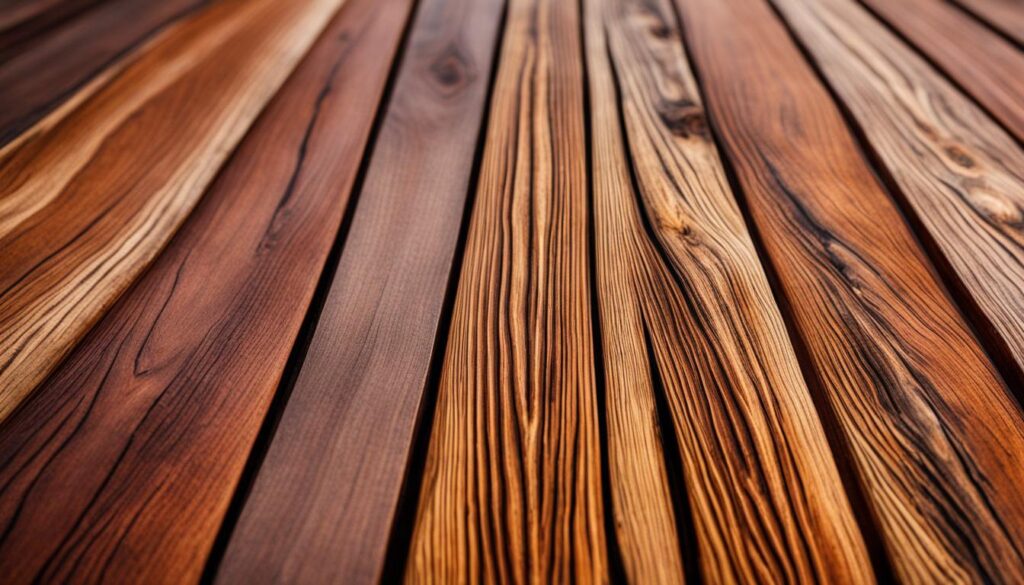
Bring Longevity and Beauty to Your Outdoor Space
Choosing the best wood for your outdoor furniture projects is essential for creating pieces that last. By selecting recommended wood species like white oak, black locust, bald cypress, eastern red cedar, or northern white cedar, you can enjoy the benefits of durability, resistance to decay, and aesthetic appeal. Whether you prefer hardwoods or softwoods, these wood species offer the qualities needed to withstand outdoor conditions and provide lasting beauty for your outdoor space.
Conclusion
Choosing the right wood for your outdoor furniture is essential for its durability and longevity. Whether you opt for hardwoods like teak or softwoods like cedar, each wood type offers unique advantages in terms of weather resistance, aesthetics, and maintenance.
Consider important factors such as your budget, the climate of your region, and the surface of your patio when selecting the wood species for your outdoor furniture. By taking these factors into account, you can ensure that your furniture will withstand the test of time and the elements.
Remember to protect your outdoor wood furniture by using fitted covers and high-quality protectants. This will help maintain its appearance and extend its lifespan, allowing you to enjoy your furniture for years to come.
By following these guidelines and using the best wood for your outdoor furniture, you can create a beautiful and durable outdoor space that will be the envy of your friends and neighbors.
FAQ
What is the best wood for outdoor furniture?
The best wood for outdoor furniture is typically hardwoods such as teak, which repels water, deters insects, and doesn’t warp with changes in humidity. Softwoods like cypress, redwood, and cedar also have natural moisture-wicking properties and are suitable for outdoor use.
What are the main types of wood for outdoor furniture?
The two main types of wood for outdoor furniture are hardwoods and softwoods. Hardwoods like teak, ipe, and mahogany are known for their strength and density, while softwoods like cypress, redwood, and cedar have natural moisture-wicking properties.
Why is teak considered the best wood for outdoor furniture?
Teak is considered the best wood option for outdoor furniture due to its exceptional durability and weather resistance. It can withstand harsh outdoor conditions and will weather to a beautiful silver-gray color over time.
How do I choose the right wood for outdoor furniture?
When choosing the wood for outdoor furniture, factors such as budget, climate, and the patio surface should be considered. Different wood materials come at various price points, and investing in quality wood ensures longevity.
How can I protect outdoor wood furniture?
To protect wood furniture, using fitted furniture covers and applying a high-quality protectant is recommended. Regular maintenance and cleaning with a simple solution of soap and water are essential for preserving the appearance and lifespan of outdoor wood furniture.
What are the recommended wood species for outdoor furniture projects?
The recommended wood species for outdoor furniture projects are white oak, black locust, bald cypress, eastern red cedar, and northern white cedar. These wood species offer durability, resistance to decay, and aesthetic appeal.


